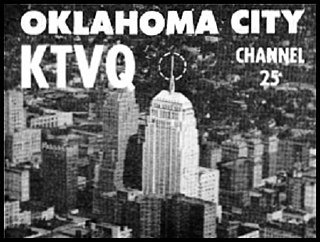
KDNL-TV is a television station in St. Louis, Missouri, United States, affiliated with ABC. Owned by Sinclair Broadcast Group, the station maintains studios at the University Tower in the suburb of Richmond Heights and a transmitter in Shrewsbury.

WATL is a television station in Atlanta, Georgia, United States, affiliated with MyNetworkTV. It is owned by Tegna Inc. alongside NBC affiliate WXIA-TV. The two stations share studios at One Monroe Place on the north end of midtown Atlanta. WATL's transmitter shares a broadcast tower with several other local stations near North Druid Hills, just northeast of the city.
KTVI is a television station in St. Louis, Missouri, United States, affiliated with the Fox network. It is owned by Nexstar Media Group alongside CW owned-and-operated station KPLR-TV. The two stations share studios on Ball Drive in Maryland Heights; KTVI's transmitter is located in Sappington, Missouri.

KMOV is a television station in St. Louis, Missouri, United States, affiliated with CBS. It is owned by Gray Television alongside low-power station KDTL-LD. The two stations share studios on Progress Parkway in suburban Maryland Heights; KMOV's transmitter is located in Lemay, Missouri.

KPLR-TV is a television station in St. Louis, Missouri, United States, serving as the market's outlet for The CW. It is owned and operated by network majority owner Nexstar Media Group alongside Fox affiliate KTVI. The two stations share studios on Ball Drive in Maryland Heights; KPLR's transmitter is located in Sappington, Missouri.
WRBU is a television station licensed to East St. Louis, Illinois, United States, broadcasting the Ion Television network to the St. Louis, Missouri area. Owned and operated by the Ion Media subsidiary of the E. W. Scripps Company, the station has offices on Richardson Road in Arnold, Missouri, and its transmitter is located near Missouri Route 21 and East Four Ridge Road in House Springs.
WTVI is a PBS member television station in Charlotte, North Carolina, United States, owned by Central Piedmont Community College. The station's studios are located in the Chantilly-Commonwealth section of east Charlotte, and its transmitter is located in the unincorporated area of Newell in northeastern Mecklenburg County. It is the only public television station in North Carolina that is not operated by PBS North Carolina, and is one of three PBS member stations serving the Charlotte metropolitan area, along with PBS North Carolina's WUNG-TV in Concord and South Carolina Educational Television (SCETV)'s WNSC-TV in Rock Hill.

WCAN-TV was a television station in Milwaukee, Wisconsin, United States, which operated from 1953 to 1955. It was the second television station and first ultra high frequency (UHF) outlet in Milwaukee and was owned by Midwest Broadcasting Company. Affiliated with CBS throughout its history, it shut down when the network bought its primary competitor, WOKY-TV, taking with it the CBS affiliation; Poller sold the physical plant to CBS, while the WCAN-TV construction permit remained active and in force until 1969.

KTVQ was a television station in Oklahoma City, Oklahoma, United States, which operated from November 1, 1953, to December 15, 1955. The station was owned by the Republic Television and Radio Company. KTVQ's studios were located on Northwest 19th Street and North Classen Boulevard in northwest Oklahoma City's Mesta Park neighborhood, and its transmitter was located atop the First National Bank Building on North Robinson and Park avenues in downtown Oklahoma City.
KCTY was a television station in Kansas City, Missouri, United States. It broadcast on ultra high frequency (UHF) channel 25 from June 6, 1953, to February 28, 1954, and was the second television station to begin broadcasting in the Kansas City area after WDAF-TV. KCTY was an affiliate of the DuMont Television Network; originally owned by the Empire Coil Company, which had pioneered UHF telecasting, DuMont purchased the station outright at the end of 1953 and operated it for two months as a study in the problems of struggling UHF stations nationwide before concluding that there was no path to economic viability. The studio for KCTY was located in the Pickwick Hotel in downtown Kansas City; the transmitter was located in a rural area that today is part of Overland Park, Kansas.

WROV-TV was a television station on ultra high frequency (UHF) channel 27 in Roanoke, Virginia, United States. It broadcast from March 2 to July 18, 1953, becoming the first UHF station in the United States to cease broadcasting. Its failure was the first of many in the early days of UHF television, which was hindered by signal issues in mountainous areas and the lack of UHF tuning on all television sets—a problem not resolved until the All-Channel Receiver Act took effect in 1964.
WNAO-TV, UHF analog channel 28, was a CBS-affiliated television station licensed to Raleigh, North Carolina, United States. Owned by the Sir Walter Television Company, it was the first television station in the Raleigh–Durham area and the first UHF television station in North Carolina, broadcasting from July 12, 1953, to December 31, 1957. The station closed because of the establishment of higher-powered, more accessible very high frequency (VHF) television stations in the region.
WKNY-TV was a television station in Kingston, New York, United States, which served the Hudson Valley from May 1954 to July 1956. Owned alongside radio station WKNY, it broadcast from studios and a transmitter site in Port Ewen, south of Kingston. Economic issues inherent with early ultra high frequency (UHF) stations led to its demise. It was approved to move to channel 21 but never did so.
KNUZ-TV was a television station broadcasting on ultra high frequency (UHF) channel 39 in Houston, Texas, United States, affiliated with the DuMont Television Network. It signed on the air on October 22, 1953, as Houston's third television station and first UHF outlet; it closed on June 25, 1954, after having lost money its entire existence and competing with two existing commercial very high frequency (VHF) outlets. KNUZ-TV's studios and transmitter were located at 4343 Cullen Boulevard in the Texas Television Center on the University of Houston campus.
WTVI was a television station in Fort Pierce, Florida, United States. It was the first television station to operate in the Treasure Coast region. The station made two unsuccessful attempts operating, once from November 1960 to January 1961 and again from September 1961 to January 1962. Financial problems related to its UHF operation and competition from a local cable system doomed the venture. WTVI equipment, buildings and personnel later were used in the start-up of two other stations, one of them in Fort Pierce.
WIRK-TV, UHF analog channel 21, was a television station licensed to West Palm Beach, Florida, United States. It was the first television station in the Palm Beach area, signing on September 13, 1953. However, it was quickly overshadowed by new VHF stations, which took away its network affiliations, and ceased telecasting February 29, 1956.

KTVE, UHF analog channel 32, was an independent television station licensed to Longview, Texas, United States, that operated from 1953 to 1955. KTVE was one of the first television stations in east Texas. However, its use of the quickly outmoded UHF, and the arrival of a VHF station in the form of KLTV, made continued operation unviable, and the station closed on Christmas Day 1955.

WFMZ-TV, UHF analog channel 67, was an independent television station licensed to Allentown, Pennsylvania, United States, which broadcast from December 4, 1954, to April 15, 1955. Owned by the Penn-Allen Broadcasting Company, it was sister to radio station WFMZ. WFMZ-TV failed due to economic issues inherent in early UHF broadcasting and the availability of network-affiliated stations from Philadelphia.

WENS was a television station broadcasting on ultra high frequency (UHF) channel 16 in Pittsburgh, Pennsylvania, United States, from 1953 to 1957. An ABC and CBS affiliate, it was one of two early UHF television stations in Pittsburgh. The arrival of stronger very high frequency (VHF) stations and struggles generally applicable to UHF broadcasting in the early years of television prompted the station to close and sell its technical facilities to educational broadcaster WQED for use as a second educational channel, WQEX.










